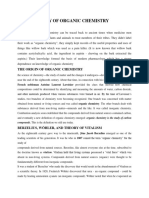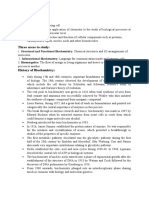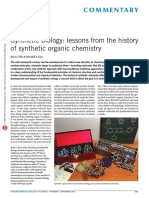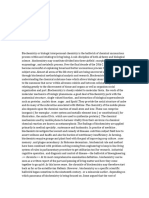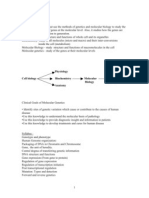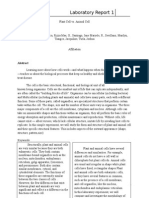A History of Biochemistry
A History of Biochemistry
Uploaded by
koyerin0420Copyright:
Available Formats
A History of Biochemistry
A History of Biochemistry
Uploaded by
koyerin0420Copyright
Available Formats
Share this document
Did you find this document useful?
Is this content inappropriate?
Copyright:
Available Formats
A History of Biochemistry
A History of Biochemistry
Uploaded by
koyerin0420Copyright:
Available Formats
Before the nineteenth century, chemists believed the world to be made of either “living
matter” or “non-living matter”. They thought that the processes of life were unlike the
processes of nature. They assumed life could not be explained by the laws of physics and
chemistry alone. They argued that the molecules of life could only be made by the living
organisms themselves. It was not until 1828, when the German chemist Friedrich Wohler
created an organic compound from inorganic matter, that the field of biochemistry began
to develop. It became a new branch of science dealing with the chemistry of living
systems. Since Wohler’s discovery, chemists have made significant advances in
understanding the chemical structure and functioning of biological molecules.
Friedrich Wohler was twenty-eight-year-old chemist and medical scholar. He accidentally
produced the organic compound urea while experimenting with certain inorganic
compounds. Urea is found in the urine of most animals. His finding demonstrated that a
compound thought to be created only by animate beings could be artificially synthesized
in a laboratory. They thus disproved the theory that an undefined “life force” was needed
for the production of organic matter. Five years after the publication of Wohler’s results,
the French chemist Anselme Payen discovered the first known enzyme. Enzymes are
proteins that speed up or slow down chemical reactions in the body. Payen’s enzyme was
called diastase. Diastase is a type of enzyme responsible for the breakdown of starches
into maltose. Starches are complex carbohydrates found commonly in potatoes and rice.
Maltose is a sugar. Payen found diastase in a malt solution. He created the solution using
grain sugar. In 1897, Edward and Hans Buchner of Germany furthered the understanding
of enzyme function. Their experiments used extracted enzyme-containing material from
yeast cells. The brothers demonstrated that the inanimate material could ferment sugar.
They showed that “dead” cellular compounds can perform the chemical reactions of
living cells.
By the turn of the century, chemists such as Emil Fischer had contributed effective
methods of separating and identifying basic biological molecules. These molecules
included various proteins. Carbohydrates, and enzymes. The actual field of biochemistry
was not recognized, however, until the early 1900s when Carl Neuber formally coined the
term. Studies in biochemistry continued into the twentieth century. The goal was to
provide chemical explanations for how cells carry out certain metabolic processes. It was
discovered, for example, that the presence of specific sets of enzymes within a cell will
facilitate specific chain reactions. It was also discovered that carbohydrates share similar
molecular structures and that proteins are synthesiezed by the bonding of simpler
molecules called amino acids.
The next major breakthrough in biochemistry did not occur until 1943. That year, an
American physician and medical researcher, Oswald Avery, found the culprit of hereditary
traits. Deoxyribonucleic acid, more commonly known as DNA, was first isolated by Swiss
biologist Friedrich Miesher during the latter decades of the nineteenth century. By the
twentieth century, the structural form of DNA was already being studied. Avery’s famous
1940s experiment transferred traits of one type of bacteria onto another type. He did this
by mixing dead cells of the first type with live cells of the second. His experiment
provided the first confirmation of the link between DNA and inherited characteristics. A
decade later, scientists James D> Watson and Francis Crick gave the first accurate
account of DNA structure. Then, in 1957, they presented the process of genetic encoding
in DNA<. Their work demonstrated that the specific information carried in DNA was
responsible for the synthesis of specific proteins. These proteins then carried out specific
cellular functions to complete the encoding process.
Biochemistry continued to advance with the development of new technologies and
techniques. These included chromatography, which is used in the separation of mixtures,
and x-ray crystallography, used in the analysis of molecular structure. Although these
innovations havel ed to the discovery and detailed understanding of many molecular
structures and metabolic processes of living cells, biochemistry remains a vast subject of
study that seeks to explain how chemical elements are incorporated into highly complex
organic molecules. This field is still expanding. Reaserchers continue to uncover the
specific functions of these elements in living systems. The research supports the theory
that life arises from chemical and physical processes.
You might also like
- A Level Biology For OCR A (Double Paged)Document360 pagesA Level Biology For OCR A (Double Paged)squishyboitae33% (3)
- Cambridge International As and A Level Biology Students Book 2nd Edition (C. J. Clegg, Geoff G..Document547 pagesCambridge International As and A Level Biology Students Book 2nd Edition (C. J. Clegg, Geoff G..shahidul islamNo ratings yet
- Biology Laboratory Manual PDFDocument314 pagesBiology Laboratory Manual PDFL H50% (2)
- Human Anatomy & Physiology Marieb Chapter 1Document6 pagesHuman Anatomy & Physiology Marieb Chapter 1JayjayNo ratings yet
- Csec Biology Work BookletDocument77 pagesCsec Biology Work BookletDevi Rambaran100% (4)
- Formative Assessment BiologyDocument2 pagesFormative Assessment Biologyroosita damayantiNo ratings yet
- Bch2301 Lecture Notes 4 BCH StudentsDocument17 pagesBch2301 Lecture Notes 4 BCH StudentsAmeer AmeenuNo ratings yet
- Analytical Chemistry Emman 2Document22 pagesAnalytical Chemistry Emman 2websterbambico11No ratings yet
- De Guzman, John MichaelDocument3 pagesDe Guzman, John MichaelMiko de GuzmanNo ratings yet
- Biochemistry: Molecular and Cell BiochemistryDocument7 pagesBiochemistry: Molecular and Cell BiochemistryKHIENT CARLO MARTINNo ratings yet
- Untitled DocumentDocument2 pagesUntitled DocumentShani BergonioNo ratings yet
- Biochemitry WidyaDocument2 pagesBiochemitry WidyaWidya AngreyaniNo ratings yet
- History of BiochemistryDocument3 pagesHistory of BiochemistryAmisha ChakrabortyNo ratings yet
- Brief History of Organic ChemistryDocument4 pagesBrief History of Organic Chemistryubonge822No ratings yet
- Biochemistry Chapter 1 and 2Document120 pagesBiochemistry Chapter 1 and 2Fumofu_2No ratings yet
- Biochemistry DefinitionDocument4 pagesBiochemistry DefinitionRamcés Ramos HinostrozaNo ratings yet
- BiochemDocument7 pagesBiochemDeane Marc TorioNo ratings yet
- Lecture 1 - History of BiochemistryDocument3 pagesLecture 1 - History of Biochemistryvia.edit19No ratings yet
- Entre The Microcosmos of Life - : Introduntion To BiochemistryDocument48 pagesEntre The Microcosmos of Life - : Introduntion To BiochemistryEINSTEIN2DNo ratings yet
- History of BiochemistryDocument31 pagesHistory of BiochemistryaleezehkhanamNo ratings yet
- INTRODUCTION TO BIOCHEM Revised 24Document103 pagesINTRODUCTION TO BIOCHEM Revised 24Ashy NicoleNo ratings yet
- Unit I Introduction of Life Science St. TimothyDocument9 pagesUnit I Introduction of Life Science St. TimothyKarl Louie OlaveNo ratings yet
- session 1Document7 pagessession 1maddulasrijaNo ratings yet
- HistoryDocument9 pagesHistoryCeciliaLunaNo ratings yet
- Biochemistry 1Document7 pagesBiochemistry 1MituSamadderNo ratings yet
- Biotech Lesson 1Document53 pagesBiotech Lesson 186x2yr8ng4No ratings yet
- History of Cell BiologyDocument3 pagesHistory of Cell BiologyMegurine Luka100% (1)
- Bab 1 History of Cell Biology: A. IntroductionDocument20 pagesBab 1 History of Cell Biology: A. IntroductionWahdania MisliyantiNo ratings yet
- Brief History of Cell DiscoveryDocument3 pagesBrief History of Cell DiscoveryRobert Ford100% (1)
- UNIT 1 Introduction of Life Science Group 1Document32 pagesUNIT 1 Introduction of Life Science Group 1Karl Louie OlaveNo ratings yet
- CellDocument3 pagesCellwahyu kurniawanNo ratings yet
- Molecular Biology AssignmentDocument11 pagesMolecular Biology AssignmentgiovannigideNo ratings yet
- 66d13850816d25c181c16616 ViwajabekolevumoxDocument4 pages66d13850816d25c181c16616 ViwajabekolevumoxvishnusvkalladaNo ratings yet
- Microbiology Notes1Document23 pagesMicrobiology Notes1kato.mp2040No ratings yet
- Comprehensive Timeline of Biological DiscoveriesDocument3 pagesComprehensive Timeline of Biological DiscoveriesPaula GuerreroNo ratings yet
- History of BiochemDocument1 pageHistory of BiochemAngelNo ratings yet
- Synthetic Biology: Lessons From The History of Synthetic Organic ChemistryDocument5 pagesSynthetic Biology: Lessons From The History of Synthetic Organic ChemistryJenny ZevallosNo ratings yet
- History of Cell BiologyDocument5 pagesHistory of Cell BiologyGusMar OyNo ratings yet
- Share CYTOLOGYDocument3 pagesShare CYTOLOGYTalhaNo ratings yet
- Enrichment Bio ActivityDocument8 pagesEnrichment Bio ActivityPrincess Bea PengsonNo ratings yet
- Biochemistry - WikipediaDocument14 pagesBiochemistry - WikipediaAchilles ManthosNo ratings yet
- BCH 201 General Biochemistry Nov2018-1Document97 pagesBCH 201 General Biochemistry Nov2018-1Karen AgbaegbuNo ratings yet
- Foundation of GeneticsDocument16 pagesFoundation of GeneticsAnonymous 1uezxyeYNo ratings yet
- B2Document3 pagesB2Regging ChegiNo ratings yet
- BiochemistryDocument3 pagesBiochemistryArnold WaaggerNo ratings yet
- Microbiology History and ScopeDocument3 pagesMicrobiology History and ScopeAngelica ManzanoNo ratings yet
- History and Introduction of BiochemistryDocument1 pageHistory and Introduction of BiochemistryMuhammad Uzair ShahNo ratings yet
- Basics of Enzymology 09Document130 pagesBasics of Enzymology 09RUSHIKESH SINDKHEDKARNo ratings yet
- Biology3 Amazing DiscoveriesDocument28 pagesBiology3 Amazing DiscoveriesRommel F. delos SantosNo ratings yet
- Ncert Biology ScientistsDocument13 pagesNcert Biology ScientistsSrujana ShettiNo ratings yet
- Fundamentals of GeneticsDocument254 pagesFundamentals of GeneticsRahul YadavNo ratings yet
- Module 7 CytogeneticsDocument37 pagesModule 7 CytogeneticsJash SamaNo ratings yet
- Lesson 1 - MicrobiologyDocument4 pagesLesson 1 - MicrobiologyRudlyann BaltazarNo ratings yet
- The Cell Theory TimelineDocument16 pagesThe Cell Theory TimelinesilvajunjosephNo ratings yet
- Unknownfiles 0Document3 pagesUnknownfiles 0RJ TannieNo ratings yet
- Chapter 1.1Document70 pagesChapter 1.1AS2012B2 FATIN NUR AQILAH BINTI DAZALINo ratings yet
- Zacharias Janssen: Van LeeuwenhoekDocument4 pagesZacharias Janssen: Van LeeuwenhoekCharl BaranganNo ratings yet
- CellDocument3 pagesCellBeatrice de CastroNo ratings yet
- History of CellDocument2 pagesHistory of CellFengyiNo ratings yet
- Biological DiscoveriesDocument3 pagesBiological DiscoveriesConrad Janus GonzalezNo ratings yet
- Biology Science of LifeDocument2 pagesBiology Science of LifeIssa RomeroNo ratings yet
- Model BuildingDocument5 pagesModel BuildingFarhanBaqiNo ratings yet
- Chapter 2 (Origin of Life)Document45 pagesChapter 2 (Origin of Life)dramascenes8No ratings yet
- Earth and Life Sciences Quarter 2Document105 pagesEarth and Life Sciences Quarter 2Arr FernandezNo ratings yet
- Biology (Farmacia-Qu+¡mica-Bioqu+¡mica)Document2 pagesBiology (Farmacia-Qu+¡mica-Bioqu+¡mica)Leandro BustinceNo ratings yet
- Notes Topic 1 - Cell BiologyDocument8 pagesNotes Topic 1 - Cell Biologyjamina.lagacheNo ratings yet
- Bio Chapter 1.2Document14 pagesBio Chapter 1.2Edchel EspeñaNo ratings yet
- (Very Short Introductions) Dorothy H. Crawford - Viruses - A Very Short Introduction-Oxford University Press (2011)Document173 pages(Very Short Introductions) Dorothy H. Crawford - Viruses - A Very Short Introduction-Oxford University Press (2011)ZaidGoovay100% (1)
- Essential Chemistry BiochemistryDocument119 pagesEssential Chemistry BiochemistryAnneGuran100% (1)
- Book Microbiology Part IDocument141 pagesBook Microbiology Part Idchs.okaraNo ratings yet
- Faisalabad Board: Grade 9 Biology 2016 GROUP 1Document11 pagesFaisalabad Board: Grade 9 Biology 2016 GROUP 1DEPUTY DIRECTOR SOCIAL WELFARENo ratings yet
- Hawassa University College of AgricultureDocument31 pagesHawassa University College of Agriculturehilina workuNo ratings yet
- Science Syllabus (7-8) 2023 2024 ApprovedDocument15 pagesScience Syllabus (7-8) 2023 2024 ApprovedSaheed AbdulkarimNo ratings yet
- I. Simple Recall. Identify The Following. Write The Answers After The QuestionDocument2 pagesI. Simple Recall. Identify The Following. Write The Answers After The QuestionTurlingNo ratings yet
- The Making of A Scientist English 10Document30 pagesThe Making of A Scientist English 10siaNo ratings yet
- 1 Molecular GeneticsDocument10 pages1 Molecular GeneticsAbdullah Sawalha100% (1)
- Animal Cell Vs Plant CellDocument4 pagesAnimal Cell Vs Plant CellRizza Mae Samalca100% (2)
- PreviewpdfDocument57 pagesPreviewpdfAISHANo ratings yet
- Activity Sheet 2the Basic Unit of Life.Document8 pagesActivity Sheet 2the Basic Unit of Life.Marlou GayaneloNo ratings yet
- Zoology 232 NotesDocument36 pagesZoology 232 NotesKevinNo ratings yet
- BIO111 - S - Chandrasekaran Syllabus - Fall 2021Document7 pagesBIO111 - S - Chandrasekaran Syllabus - Fall 2021Seth JonesNo ratings yet
- Biology Syllabus 2020Document9 pagesBiology Syllabus 2020Tainu KeeNo ratings yet
- Essay On HolesDocument8 pagesEssay On Holesfesegizipej2100% (2)
- Cell StructureDocument90 pagesCell StructureYashwinni VijayasekarNo ratings yet
- GenBio w2 1Document9 pagesGenBio w2 1MonicDuranNo ratings yet
- Animal Tissue CultureDocument23 pagesAnimal Tissue CultureHui Jun Hoe80% (5)
- Bio Chapter 3 Form 4 Part 2Document7 pagesBio Chapter 3 Form 4 Part 2Tishan 10No ratings yet
- Central Dogma of BiologyDocument6 pagesCentral Dogma of BiologyJhun Lerry TayanNo ratings yet
- The Great Age Reboot WorkbookDocument46 pagesThe Great Age Reboot WorkbookMihael SmileskiNo ratings yet













